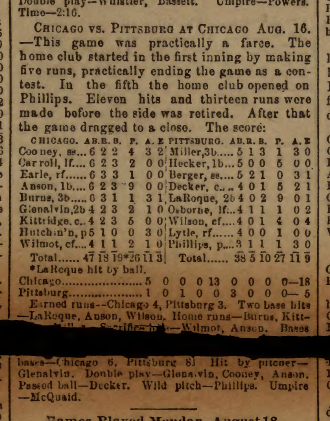Historical Hitter August 16 1890: Malachi Kittridge and Tom Burns

It has been famously said that there’s no crying in Baseball. One of the few exceptions to that baseball bylaw is the two days of August 16-17. It was on August 16, 1948 that the Babe died, and in 1920–with the Babe as a witness–Ray Chapman was first beaned and then died some 12 hours later in the early morning of August 17, 1920.
Some of the more compelling stories found online are:
http://www.leaguepark.org/chapman.html
http://www.cleveland.com/livingston/index.ssf/2013/08/almost_a_century_after_the_pit.html
and the book The Pitch That Killed, by Mike Sowell
On a more positive note, on August 16, 1890 one of the rarest events occurred; two grand slam home runs in one inning. This is the first time in recorded baseball that event has occurred. The two players were Malachi Kittridge and Tom Burns of the Cubs, then called the Colts, off of Phillips of the Pirates. The game was played in the old West Side Baseball Grounds in Chicago. No doubt the wind was blowing out that day. The final score was 18-5, with the famous inning being the 5th when the Chicago National Leaguers scored 13 runs.
One of the big issues is why look at a game from the 19th Century? The mound was not at the regulation distance in 1890, the level of play was not as good, during 1890 there was an alternate league, the Players League, which watered down the talent. What can possibly make this such an event? The answer almost a trivia contest winning one- the next time this event occurred was on April 23, 1999. What was it? Two grand slams in one inning.
Even though hitting two grand slams is a unique feat, there is no mention in it in the game description. The box score is shown below. It was taken from Sporting Life Magazine, Volume 15 Number 21, August 23, 1890 edition. The first sentence appropriately defines this one sided game as, “practically a farce.” The Pittsburgh Dispatch of August 17, 1890 described it as, “… Phillips hit hard and errors added to make it a truly bad game.” And being the losing team’s home paper summarized the 5th inning as “… hitting Phillips’ delivery at leisure.”

The 1890 Cubs were managed by Cap Anson, and finished second in the eight-team National League. The eighth team was the old Cleveland Spiders who after being cannibalized by their ownership soon failed. In 1893 the Pittsburgh team finished last and were bad, epically bad, going 23-113 with a winning percentage of .169, a hefty 66.5 games out (by comparison the 1962 Mets finished with a .250 WP, and only 60.5 games back.) 1890 was one of baseball’s poorest years either on the field or off the field.
The unlucky pitcher was Bill “Silver Bill” Phillips who was a 21 year old rookie in 1890, and perhaps only pitching due to the Players league talent drain. That dreadful season’s stats were 1-9 with a 7.57 ERA – sometimes wins and era tell the story. He remained in baseball and returned some years later playing well for the Reds. Overall he played seven years in the National League achieving success with the Reds of 1899. Later he managed 1914 Indiana Hoosiers to the Federal League pennant, and also the Federal League, Newark Pepper.
Here are the two batting heroes. On the surface they both had less than stellar careers in baseball, but both were baseball lifers, and at one time managers after their playing days and more noted for their defense than hitting.
 Malachi Kittridge was catcher in an era of small mitts, no shin guards, but masks and chest protectors. 1890 he was a rookie 20 year old who became the starting catcher for the Cubs. He played 16 seasons, 1216 games, in the majors from 1890 to 1906, all as a catcher. The vital batting stats were deadball .219 BA, with an OPS+ was 56. Like many in that era, the stats were not home run based: he hit 35 triples with just 17 home runs in those big wooden ball parks of the day. Kittridge was the interim player-manager of the 1904 Washington Senators at the start of the season. He has the dubious distinction of having a managerial record of 1-16, a .059 winning percentage.
Malachi Kittridge was catcher in an era of small mitts, no shin guards, but masks and chest protectors. 1890 he was a rookie 20 year old who became the starting catcher for the Cubs. He played 16 seasons, 1216 games, in the majors from 1890 to 1906, all as a catcher. The vital batting stats were deadball .219 BA, with an OPS+ was 56. Like many in that era, the stats were not home run based: he hit 35 triples with just 17 home runs in those big wooden ball parks of the day. Kittridge was the interim player-manager of the 1904 Washington Senators at the start of the season. He has the dubious distinction of having a managerial record of 1-16, a .059 winning percentage.
 Tom Burns played 3rd base and was part of an infield with the moniker of the “Stone Wall infield.” Being a complement, from 1886 to 1890 he was a league top 5 in double plays, fielding percentage, assists, errors, and games played.
Tom Burns played 3rd base and was part of an infield with the moniker of the “Stone Wall infield.” Being a complement, from 1886 to 1890 he was a league top 5 in double plays, fielding percentage, assists, errors, and games played.
On the hitting side, he is recording for having a two big innings. The first was September 6, 1883, he had three hits and scored three runs, against the old Detriot Wolverines with the final score being 26-6. And of course the second is August 16, 1890, 5 inning against the Pirates.
He too was a favorite of Cap Anson, and became the manager of the club when Cap retired, during the time period when team was renamed the “Orphans.”
“He (Tom Burns) was a fair to average batter, but was hardly fast enough to be considered a really good shortstop. He was a fair baserunner, using a first-class slider, going into the bases head first. In fact, he was more of a diver than a slider. At third base Burns was as good as the best of them, he excelled at the blocking game, which he carried on in a style that was particularly his own and which was calculated to make a baserunner considerable trouble.” – Hall of Famer Cap Anson in Nineteenth Century Stars (1989)
Sources:
Baseball Reference.com
This day in baseballhistory.com
Sporting Life, Vol 15, No 21, August 23, 1890
Pittsburgh Dispatch, August 17, 1890
